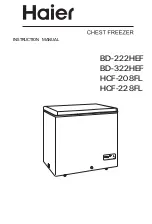
18
•
Fresh food should be frozen as fast as possible to
the core. Therefore during freezing operation, the
temperature of fresh food should be lowered as
fast as possible in order to keep formation of ice
crystals as little as possible and not to damage
the food structure.
•
Frozen food should be kept in contact with the
bottom of the compartment.
•
Keep a space between the individual items, so
that the cold air can circulate.
Storing frozen food
Storing frozen food
Storing frozen food
Storing frozen food
•
Packed frozen merchandise should be stored in a
4-star-freezer compartment in accordance with
the manufacturer’s data. Make sure the food
items do not defrost after purchase and to store
them as fast as possible in the freezer.
•
It is possible to store food for longer periods of
time, up to three months. This period might vary,
so observe the storage information on the pack-
aging of the merchandise.
General safety precautions
General safety precautions
General safety precautions
General safety precautions
•
Do not exceed the maximum freezing capacity.
See data under "Technical Data" and on the rat-
ing label.
•
Do not store bottles or cans. These can break
when the contents freeze – or even explode, if
they contain carbonated drinks.
•
Once products have been defrosted halfway or
completely, they should be consumed as soon as
possible and should not be frozen again, except
they have been processed to a ready meal.
•
Do not open the door in case of power failure. If
the failure does not take longer than 24
24
24
24 hours
hours
hours
hours, the
food will not be affected.
•
Do not eat food that is still frozen. Do not eat ice
cream directly from the freezer. The cold can
cause injuries in the oral cavity.
•
Touching metal parts inside the appliance can
cause symptoms similar to burns if the skin is very
sensitive.
•
Never touch frozen food with moist or wet hands.
Operating noise
Operating noise
Operating noise
Operating noise
Type of sound
Type of sound
Type of sound
Type of sound
Cause
Cause
Cause
Cause
Mumbling
Compressor during its operation
Liquid sounds
Circulation of the refrigerant
Click sounds
The temperature control turns the
compressor on or off
Disturbing
noises
Vibration of the shelves or cooling
coils
Switching
Switching
Switching
Switching off
off
off
off
To switch the appliance off, disconnect it from the
To switch the appliance off, disconnect it from the
To switch the appliance off, disconnect it from the
To switch the appliance off, disconnect it from the
power su
power su
power su
power suppppply.
ply.
ply.
ply.
If the appliance is out of use for long periods:
•
Remove the appliance content.
•
Thoroughly clean the appliance (see ”Cleaning
and Maintenance”).
•
Leave open the appliance door to prevent un-
pleasant odours.
Tips for Energy saving
Tips for Energy saving
Tips for Energy saving
Tips for Energy saving
•
Disconnect the appliance from the power supply if
the appliance is not in use.
•
Do not install the appliance near stoves, heaters
or other heat sources. In case of higher ambient
temperatures, the compressor will run more fre-
quently and longer.
•
Ensure sufficient ventilation at the bottom and
rear side. Never block ventilation openings.
•
Allow warm dishes to cool down before putting
into the appliance.
•
Do not adjust the temperature colder than neces-
sary.
•
Do not open the door longer than necessary.
•
The appliance should be defrosted regularly.







































